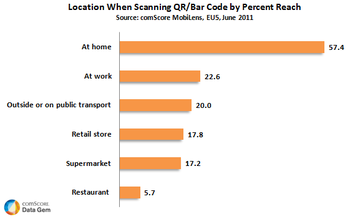The near future of Augmented Reality (AR) and QR codes
Augmented reality (AR) has a glorious future according to a new market research published by MarketsandMarkets. It will be interesting to see which role QR codes play in that future as more and more technologies arise.
The new market research report “Global Augmented Reality (AR) Market Forecast by Product (HMD, HUD, Tablet PC, Smartphone) for Gaming, Automotive, Medical, Advertisement, Defense, E-Learning & GPS Applications (2011-2016)” states that the total Augmented Reality applications market will be growing by over 95% from 2011 to 2016. The research sees it reaching a market volume of $5151,74 million.
 According to Comscore research almost 10% of all smartphone users have scanned QR codes in June this year. The interesting fact is that most users scan their QR codes from home (57,4%). In public only 20% use those QR scan options from outdoor advertising or in public transport.
According to Comscore research almost 10% of all smartphone users have scanned QR codes in June this year. The interesting fact is that most users scan their QR codes from home (57,4%). In public only 20% use those QR scan options from outdoor advertising or in public transport.
Although screen technology (smartphone, tablet and eye-wear) is still in its infancy concerning AR, and also facing some challenges, the Universities of Washington and the MIT see a better future on the experience horizont. Especially, the head up and head mounted displays have become mature, finds the study. Leading and growing in use are online apps, gaming apps and GPS apps. So far, campaigns like the following by MIRAT Paris work on the basis of QR coding…
But what kind of Augmented Reality technologies are rocking the transformation from the physical to the virtual world, or shall we say to the mobile world?
Some months ago, we only had browser technology like Layar and Wikitude. Today, companies like Tesco are experimenting with other capabilities in their retail shops. For a long time, we had to use QR codes or trigger points to initiate some activity with AR technology.
Layar’s latest innovation called “Vision” is another reason why QR codes are becoming uncool. Vision is a tool that lets advertisers and content owners integrate Augmented Reality ads in publications. As an example you may watch the Dutch magazine Linda how the technology works…
Some other technology innovations are also evolving that might catalyze the technology shift in the AR sphere. Here are three of them…
Aurasma
The Aurasma technology -unlike the GPS based technologies Layar (until the Vision version) and Wikitude that merely recognizes what someone has tagged as locations or places- is a new generation augmented reality browser. Aurasma recognises images through cameras in a way search engines recognise words. The browser then creates so-called 2D or 3D „Auras“ which show animated audio-video content. Just watch some examples of Aurasma campaigns.
blippAR
With blippAR the whole advertisment becomes the response tool. It is enough to simply point in the direction of the ad with the app. Still, the awareness challenge needs to be solved. And, the need for a specific browser to use the technology. See some examples of blippAR usage. At the moment you can even participate in the interactive blippAR campaign “escape the map” by Mercedes Benz.
Printechnologics
Printechnologics is based on Touchcode carrier technology. It contains a blind or transparent code which is embedded via invisible data storage development inside print products like carton, foil or simply paper. Printechnologics turns the AR identification around as you lay the paper on top of the tablet or smartphone, and not the other way round. And you don’t even need to modify your device, download a browser, use NFC (near field communication), or a camera for it to identify and initiate the online activity form the offline trigger. The last issue from the ICONIST carried a Printechnologics card and here you can see how it connect the two worlds….
Spot On!
In some months, the QR codes might be gone as an AR trigger, and thus leave the advertising world. However, all AR technologies have one weakness: You need to know that these technologies are embedded in any forms of campaigns. You need some trigger point, button, picture, image or QR code that people see. Thus, the main challenge for QR codes and Augmented Reality is to build awareness and understanding what it can do. Nobody is using a browser or a camera if there is no “visual” reason for virtual interactivity. I see TV using any of the forms as an extension for their TV shows in order to promote their digital content and advertising opportunities, just like the print industry did in the past. One thing is for sure: Augmented Reality will definitely become a new playground that connects the TV and online markets in the future…
What’s your view on Augmented Reality and QR codes? Let us know…

